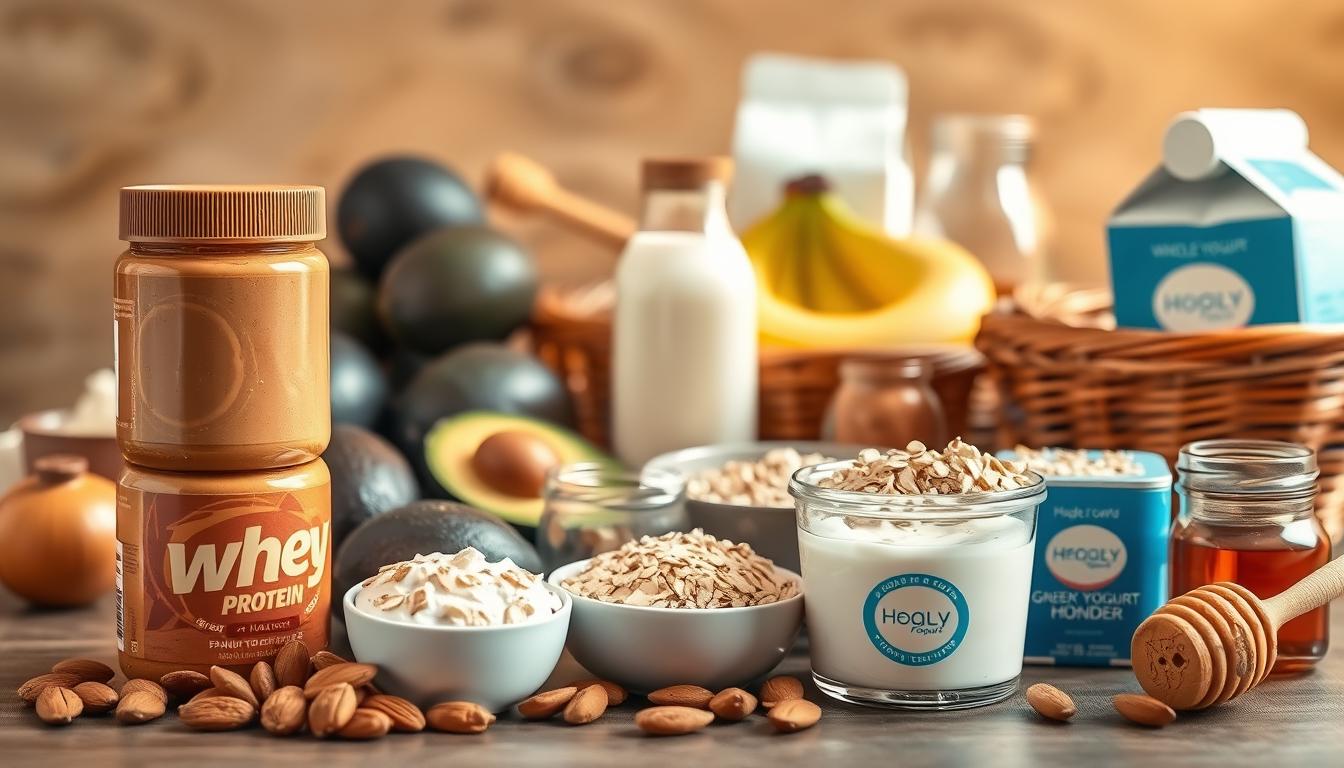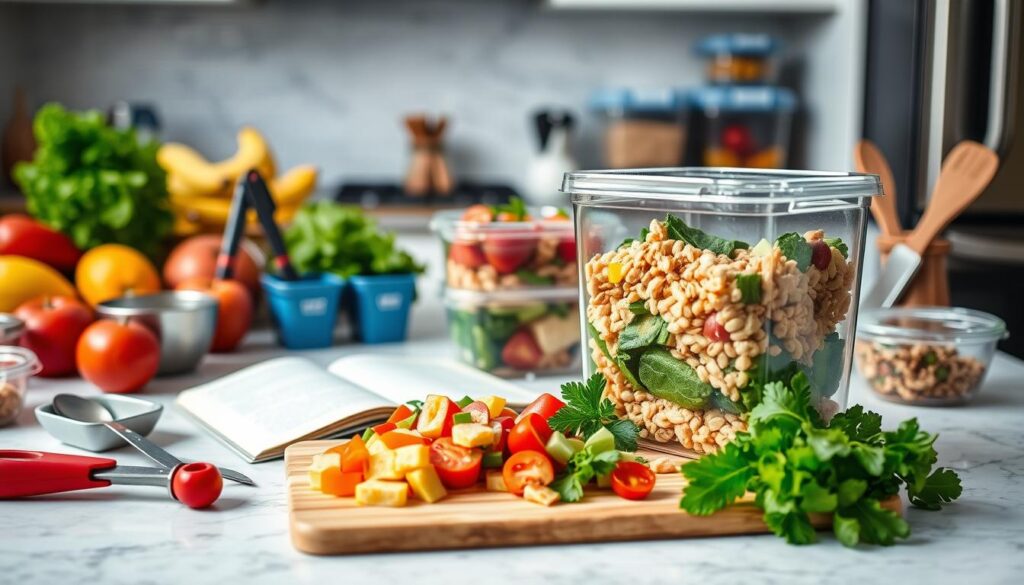Many assume that increasing portion sizes automatically leads to sustainable progress. But what if mindless eating habits actually work against your goals? Crafting a thoughtful approach matters far more than simply adding calories.
Our guide focuses on strategic meal choices that prioritize quality over quantity. By emphasizing proteins like greek yogurt and complex carbs, you fuel muscle growth without excess fat storage. Experts agree: nutrient-rich options paired with intentional timing create lasting results.
We’ll show how balancing macronutrients supports lean tissue development. This isn’t about shortcuts—it’s about building habits that align with your body’s needs. Whether you’re naturally thin or rebounding from setbacks, smart planning turns effort into achievement.
Key Takeaways
- Quality calories matter more than sheer quantity for sustainable progress.
- Greek yogurt and similar protein sources help maintain lean muscle development.
- Balanced meals prevent excessive fat accumulation during calorie increases.
- Timing your nutrient intake optimizes energy use and recovery.
- Consistent tracking ensures you meet daily targets without guesswork.
Introduction to a Healthy Weight Gain Journey
For many, achieving a stronger physique isn’t about eating more—it’s about eating smarter. Whether rebuilding after illness, enhancing athletic performance, or addressing a fast metabolism, intentional strategies to gain weight must align with individual needs. Not all bodies respond the same way, which is why a tailored strategy matters.
Calorie-rich staples like peanut butter and olive oil deliver energy efficiently. A tablespoon of peanut butter adds 90+ calories alongside protein and healthy fats. Similarly, drizzling olive oil on veggies or grains boosts intake without empty sugars. These choices support steady progress while keeping meals nutrient-focused.
Setting realistic milestones prevents burnout. Working with professionals helps design routines that fit lifestyles. Our structured meal plan, for example, breaks down 7-day frameworks to simplify tracking.
Next, we’ll explore how to balance macronutrients and adjust portions for consistent results. Small, deliberate changes often yield the most sustainable outcomes.
Understanding the Basics of a Healthy Weight Gain Diet Plan
Building a stronger body starts with math—specifically, balancing what you consume versus what you burn. Your resting metabolic rate (RMR) forms the foundation. For example, a 150-pound person needs roughly 1,800 calories daily at rest. Add activity, and this number climbs. A 30-minute jog might require an extra 300-500 calories, depending on intensity.
Why a Balanced Approach Matters
Overeating without strategy often leads to fat buildup, not muscle. We prioritize nutrient-rich foods like avocados and quinoa to fuel growth efficiently. A structured meal plan ensures you meet targets without relying on sugary shortcuts. Tools like calorie-tracking apps simplify monitoring intake and expenditure.
Identifying Your Weight Gain Goals
Start by calculating your RMR (weight x 12) and adjusting for movement. A construction worker burns more calories than an office worker—their diets should differ. A registered dietitian tailors plans using these metrics, helping you aim for 0.5-1 pound weekly. This gradual pace supports lean tissue development while minimizing fat storage.
Consistency beats extremes. Pairing smart food choices with regular check-ins creates lasting progress. Whether rebuilding strength or enhancing performance, clarity in goals turns effort into measurable results.
Key Principles Behind Safe Weight Gain
Not all calories fuel your body equally—a truth often overlooked in pursuit of progress. Choosing foods that deliver both energy and nourishment ensures steady advancement without compromising health. Let’s unpack how strategic selections create lasting results.
Calorie-Dense vs. Nutrient-Dense Foods
Calorie-rich options like nuts or dried fruit pack energy into small portions. But ultra-processed chips or candy bars? They spike calories without vitamins or minerals. “Focus on foods that multitask,” advises a Johns Hopkins nutrition study. For example, almond butter offers protein and healthy fats alongside its 190 calories per serving.
Maintaining Nutritional Balance
Pairing energy sources with nutrient powerhouses prevents gaps. Whole-grain toast with avocado provides complex carbs and heart-friendly fats. Snacks matter too—a mid-morning handful of trail mix sustains energy better than a soda.
Protein anchors muscle support. Greek yogurt with berries delivers 20 grams per cup while curbing sugar crashes. Timing matters: spacing snacks every 3-4 hours keeps metabolism active. Try these combos:
- Hummus with sliced veggies (fiber + plant-based protein)
- Cottage cheese and pineapple (calcium + natural sweetness)
Balance isn’t restrictive—it’s about maximizing every bite. By prioritizing quality, you build strength from the inside out.
Calculating Your Caloric Needs for Effective Gains
Accurate calorie targets start with understanding your body’s baseline needs. We use two key steps: determining resting energy use and adjusting for movement. This personalized approach ensures you fuel progress without guesswork.
Determining Your Resting Metabolic Rate
Your resting metabolic rate (RMR) is the energy your body burns at rest. For a quick estimate, multiply your weight in pounds by 12. A 160-pound person would need 1,920 calories daily just to maintain basic functions. Tools like the Mifflin-St Jeor equation offer more precision, but this baseline works for most.
Adjusting for Activity Levels
Next, apply an activity multiplier to your RMR:
- Light activity (office work): 1.3x
- Moderate (daily walks): 1.5x
- Heavy (construction labor): 1.7-1.9x
A 160-pound office worker would calculate 1,920 x 1.3 = 2,496 calories. Add 300-500 to this total for gradual gains.
Visualizing portions helps hit targets. A cup of whole milk adds 150 calories, while 1.5 ounces of cheddar cheese provides 170. Pair these with fiber-rich foods like roasted veggies to maintain nutrient balance. Apps like Cronometer simplify tracking, but a dietitian can refine ratios for muscle-focused results.
The Role of a Registered Dietitian in Your Weight Gain Journey
Personalized nutrition strategies often make the difference between stalled efforts and steady progress. Registered dietitians analyze your daily habits, preferences, and goals to design meal frameworks that evolve with your needs. For example, someone allergic to dairy might receive almond milk yogurt alternatives to meet protein targets without digestive discomfort.
One client struggling to add mass despite eating larger portions discovered their meals lacked balanced macronutrients. Their dietitian introduced chia seed pudding with full-fat coconut yogurt, boosting calories by 300 per day while enhancing fiber intake. This adjustment led to a 1.2-pound weekly increase within a month.
Professionals also troubleshoot plateaus. If energy levels dip mid-afternoon, they might suggest adding a pre-workout snack like dates with peanut butter. “Tailored plans account for lifestyle shifts,” notes a Mayo Clinic case study. Weekly check-ins ensure adjustments align with changing activity levels or food availability.
Collaborating with experts minimizes frustration. They calculate precise calorie thresholds, track micronutrient gaps, and celebrate milestones—turning abstract goals into actionable steps. Whether optimizing post-workout recovery or managing dietary restrictions, their guidance transforms effort into measurable outcomes.
Balancing Macronutrients for Muscle and Health
Fueling your body effectively requires more than just stacking calories—it demands a symphony of nutrients working together. Each macronutrient plays a distinct role in building strength and sustaining energy. Getting the ratios right transforms ordinary meals into growth catalysts.
Why Protein, Carbs, and Fats Matter
Lean proteins like chicken provide amino acids that repair muscle fibers after workouts. A 4-ounce serving delivers 26 grams of protein—enough to stimulate synthesis for hours. “Carbs aren’t the enemy,” explains a Sports Nutrition Journal study. They replenish glycogen stores, powering your next session.
Healthy fats from avocado or almond butter support hormone production and joint health. Just one tablespoon adds 100 calories while keeping hunger at bay. Balance these elements:
- 40% carbs (quinoa, sweet potatoes)
- 30% protein (eggs, lentils)
- 30% fats (olive oil, nuts)
Mastering Portions and Timing
Eating six smaller meals prevents energy crashes. Pair a palm-sized protein portion with fist-sized carbs post-workout. This combo spikes insulin slightly, shuttling nutrients to muscles.
Even calorie-dense plans need structure. Swap sugary snacks for trail mix with dark chocolate chips. Track portions weekly—adjust if progress stalls. Consistency turns small changes into lasting transformations.
Incorporating Whole Foods: Greek Yogurt, Eggs, and More
Choosing ingredients in their natural state unlocks hidden nutritional benefits. Whole foods like Greek yogurt and eggs deliver vitamins, minerals, and energy without artificial additives. These staples form the foundation of meals that nourish while supporting physical goals.
Benefits of Fresh, Unprocessed Ingredients
Unprocessed options provide more than calories—they offer functional advantages. A single egg contains 6 grams of protein and essential nutrients like choline, which supports brain health. Natural fats in peanuts and almonds stabilize energy levels better than refined oils.
Compare whole foods to processed alternatives:
| Nutrient | Whole Food Source | Processed Alternative | Key Benefit |
|---|---|---|---|
| Protein | Greek Yogurt | Flavored Yogurt Cups | No added sugars |
| Healthy Fats | Peanuts | Peanut Butter Snacks | Natural oils retained |
| Vitamins | Eggs | Powdered Egg Mixes | Higher bioavailability |
Meals built around these ingredients promote efficient digestion. Try scrambled eggs with spinach and avocado—a combo rich in iron and monounsaturated fats. Snack on apple slices dipped in natural peanut butter for sustained energy between meals.
Prioritizing simplicity pays off. Your body absorbs nutrients more effectively from minimally altered sources, turning everyday eating into a tool for lasting vitality.
Implementing a Healthy Weight Gain Diet Plan: Core Strategies
Success hinges on designing meals that adapt to shifting needs without losing nutritional value. Versatile frameworks allow seamless transitions between calorie targets while keeping meals satisfying. Let’s explore how to build routines that grow with your goals.
Designing Flexible Meal Structures
Start by anchoring your breakfast with nutrient-rich staples. Overnight oats made with whole milk and chia seeds provide 400+ calories and adjust easily—add honey for sweetness or nut butter for extra protein. Pair this with scrambled eggs to balance macros.
For lunch, consider base recipes like quinoa bowls. Start with 1 cup cooked quinoa (220 calories), then layer roasted veggies, grilled chicken, and avocado. Increase portions or add olive oil dressing to meet higher calorie needs.
| Calorie Goal | Breakfast Adjustments | Lunch Adjustments | Dinner Modifications |
|---|---|---|---|
| 2,000 | 1 cup oats + ½ cup berries | 4 oz chicken + 1 tbsp oil | 6 oz salmon + ½ cup rice |
| 2,500 | Add ¼ cup almonds | 6 oz chicken + 2 tbsp oil | 8 oz salmon + 1 cup rice |
| 3,000 | Include 1 banana + honey | Add cheese + avocado | 10 oz steak + sweet potato |
Regularly scheduled snacks bridge gaps. A mid-morning smoothie with milk, banana, and oats adds 300+ calories. Swap ingredients based on availability—frozen berries work when fresh ones aren’t handy.
Consistency thrives on simplicity. By mastering a few core recipes, you create endless variations that align with energy needs. This approach turns meal prep into a tool for steady, stress-free progress.
Customizing Meals with Calorie-Dense Ingredients
Transforming everyday meals into calorie powerhouses doesn’t require drastic overhauls—just clever tweaks to your pantry staples. Small additions of nutrient-rich ingredients elevate energy intake while preserving meal balance. Let’s explore how strategic enhancements turn ordinary dishes into growth-friendly fuel.
Optimizing Peanut Butter and Olive Oil Usage
Peanut butter and olive oil act as stealth calorie boosters. A tablespoon stirred into oatmeal adds 100+ calories without altering texture. Drizzling olive oil over roasted vegetables or grain bowls increases energy density by 120 calories per serving—effortlessly.
For protein-packed dinners, blend these ingredients into marinades. A glaze of peanut butter, soy sauce, and lime juice adds 150 calories to beef stir-fries while enhancing flavor. “Healthy fats amplify nutrient absorption,” notes a Harvard Health study. Pairing them with lean proteins like grass-fed beef maximizes muscle support.
| Meal | Addition | Calories Added | Key Benefit |
|---|---|---|---|
| Breakfast Smoothie | 1 tbsp peanut butter | 94 | Boosts protein + healthy fats |
| Snack Plate | 2 tsp olive oil dip | 80 | Enhances vitamin absorption |
| Beef Dinner | 1.5 tbsp PB sauce | 135 | Supports muscle recovery |
Timing matters: add oils post-cooking to preserve nutrients. Measure portions using spoons or kitchen scales to avoid overpowering meals. These micro-adjustments help hit targets without feeling overwhelmed by bulk.
Creative Snack Ideas and Meal-Prep Tips for Consistency
Struggling to keep up with calorie needs between meals? Strategic snacking bridges gaps while keeping energy levels steady. We focus on portable, nutrient-packed options that require minimal prep time—perfect for busy schedules.
Try mixing Greek yogurt with granola and berries for a 300-calorie boost. Trail mix with dark chocolate chunks and almonds delivers quick energy. For savory cravings, spread hummus on whole-grain crackers topped with sliced turkey.
Prepping salads in advance ensures consistency. Layer spinach with grilled chicken, hard-boiled eggs, and shredded cheese in mason jars. Add avocado or olive oil dressing before eating to preserve texture. These combos pack 400+ calories while staying fresh for days.
Balance sweet and savory flavors to avoid burnout. Alternate between energy balls (dates + oats + peanut butter) and roasted edamame sprinkled with sea salt. Set reminders to eat every 2-3 hours—small, frequent bites add up.
If portion sizes feel overwhelming, a dietitian can tailor snack plans to your preferences. They’ll suggest tweaks like adding chia seeds to smoothies or swapping rice cakes for denser whole-grain toast. Consistency thrives when snacks align with your tastes.
Addressing Common Challenges and Myths About Weight Gain
Myths about building a stronger physique often overshadow practical strategies. One persistent belief? That eating processed snacks accelerates progress faster than whole-food meals. Research from the Journal of Nutrition disproves this:
“Prioritizing nutrient-rich combinations like rice with grilled chicken yields better muscle retention than calorie-matched junk food.”
Many struggle with inaccurate portion sizing. Doubling rice servings without adding vegetables or proteins leads to energy crashes. A balanced plate includes:
- 1 cup cooked rice (200 calories)
- 4 oz salmon (230 calories)
- Steamed broccoli (50 calories)
Another challenge: assuming all calorie-dense foods are equal. While nuts and avocado support gradual gains, fried options often lack fiber. Swap fries for roasted sweet potatoes drizzled with olive oil—a move that adds 3g of fiber per serving.
Plateaus frequently stem from rigid routines. Try these tweaks:
- Mix brown and white rice for varied textures
- Add shredded cheese to omelets
- Use full-fat yogurt in smoothies
Simplicity wins. Pairing versatile staples like rice with rotating proteins keeps meals engaging without complicating prep. As the USDA notes, diversity in food groups ensures broader nutrient coverage—key for sustained progress.
Tracking Macronutrient Distribution and Daily Calorie Intake
Technology transforms how we approach nutrition by turning guesswork into actionable insights. Tracking macronutrients ensures you meet energy needs while maintaining nutrient balance. Apps like MyFitnessPal or Cronometer simplify this process—scan a banana, and they’ll log its 105 calories and 27g of carbs instantly.
Consistent monitoring reveals patterns. For example, adding ¼ cup granola to yogurt adds 150 calories and 4g of protein. Drizzling olive oil on roasted veggies? A tablespoon contributes 120 calories of healthy fats. These small tweaks compound over time.
Why Digital Tools Elevate Accountability
Modern apps offer features like:
- Customizable goals for carbs, proteins, and fats
- Weekly progress reports highlighting trends
- Barcode scanning for packaged foods
A 2023 study in Nutrition Today found users who tracked intake for 30 days were 63% more likely to hit targets. One participant noted:
“Seeing my protein gaps helped me add hard-boiled eggs to afternoon snacks.”
| App | Key Feature | Best For |
|---|---|---|
| MyFitnessPal | Database of 11M+ foods | Beginners |
| Cronometer | Micronutrient tracking | Advanced users |
| Lose It! | Recipe importer | Meal preppers |
Daily logging prevents overlooked gaps. If your banana smoothie falls short, the app suggests adding chia seeds or almond butter. Adjust portion sizes weekly—like swapping 1 tsp olive oil for 1 tbsp—to refine results without overwhelm.
Adapting Your Diet: Modifications for Various Calorie Goals
Tailoring your nutrition to match energy needs isn’t one-size-fits-all—it’s about precision. Metabolic rates, activity levels, and personal preferences all shape how you adjust portions. We’ll explore practical tweaks to align meals with 2,000-, 2,500-, or 3,000-calorie targets while keeping flavors vibrant.
Adjustments for 2,000, 2,500, and 3,000-Calorie Plans
A 2,000-calorie framework might include a spinach-packed omelet with feta for breakfast. Swap almond milk for whole milk in smoothies to add 50 calories. At lunch, layer hummus on whole-grain wraps—each tablespoon contributes 25 calories and 1g of protein.
For 2,500 calories, boost snacks: mix nuts into yogurt or drizzle olive oil on roasted veggies. Dinner modifications could involve doubling quinoa portions or adding avocado slices. These changes add 300+ calories without overwhelming plate sizes.
Reaching 3,000 calories demands strategic additions. Stir peanut butter into oatmeal or blend chia seeds into post-workout shakes. A personalized calorie target calculator helps refine these adjustments based on your body’s response.
Experimentation is key. Try swapping lettuce for spinach in salads—it adds iron and volume. Roast chickpeas with spices for a crunchy hummus alternative. Small shifts create big impacts when aligned with your unique needs.
Combining Diet with Exercise and Resistance Training
Building strength requires more than lifting weights—it demands precise fuel. Pairing resistance training with strategic nutrition accelerates muscle development while supporting recovery. Research shows this combination increases lean mass by 40% compared to diet alone.
Why Muscle Needs Both Movement and Nutrients
Resistance exercises create micro-tears in muscle fibers. Protein-rich meals repair these tears, leading to growth. For example, salmon provides omega-3s that reduce inflammation post-workout. A 3-ounce serving delivers 22g of protein—ideal for recovery.
Consistency matters. Training 3-4 times a week stimulates continuous adaptation. Pair sessions with snacks like almonds, which offer healthy fats and vitamin E. Studies reveal athletes consuming 1.5 ounces daily experience 18% faster recovery.
- Compound lifts (squats, deadlifts) trigger full-body muscle activation
- Post-workout meals should balance carbs and proteins within 45 minutes
- Tracking progress weekly ensures alignment between effort and intake
Balanced routines prevent plateaus. Alternate heavy lifting days with active recovery, using foods like sweet potatoes and eggs to sustain energy. Those aiming to maintain lean mass during adjustments benefit from this dual approach.
Timing amplifies results. A salmon bowl with quinoa after training replenishes glycogen stores. Snacking on almonds between meals maintains calorie surpluses without digestive strain. Together, movement and nutrition build resilient, functional strength.
Tips for Athletes and Busy Lifestyles in Gaining Healthy Weight
Juggling training and a packed calendar doesn’t mean sacrificing nutrition—it demands smarter strategies. Prioritizing portable, energy-rich meals ensures you meet calorie targets without disrupting routines. “Athletes require 20-30% more calories than sedentary individuals,” notes a Sports Medicine study, emphasizing the need for intentional planning.
Fueling Active Schedules
Time meals around workouts to maximize energy use. Eat a mix of complex carbs and proteins 90 minutes before training—like oatmeal with almond butter. Post-session, pair roasted veggies with grilled chicken drizzled with olive oil for recovery-focused nutrients.
Portable snacks bridge gaps between obligations. Try these options:
| Snack | Calories | Key Nutrients |
|---|---|---|
| Trail mix + dried mango | 280 | Iron, vitamin C |
| Whole-grain wrap with hummus | 320 | Fiber, plant protein |
| Hard-boiled eggs + carrot sticks | 200 | Vitamin A, choline |
Prep meals weekly to avoid fast-food traps. Roast batches of sweet potatoes and broccoli—toss them in olive oil for added calories. Store in containers with quinoa or brown rice for grab-and-go lunches.
Consistency trumps perfection. Keep nut packs in gym bags or desks for emergency fuel. Small, frequent meals sustain energy levels while supporting long-term health goals—even during hectic days.
Conclusion
Sustainable progress in building strength relies on strategy, not just quantity. Our guide emphasizes balance—pairing calorie-rich ingredients with nutrient quality to fuel growth efficiently. By managing portions and timing meals thoughtfully, you support muscle development while avoiding common pitfalls.
Every element matters. Nutrient-dense staples like Greek yogurt or eggs deliver essential proteins and fats. Pairing these with resistance training maximizes their impact. For example, adding a tablespoon of olive oil to roasted vegetables boosts energy intake without compromising nutrition.
Small adjustments create lasting results. Swapping processed snacks for trail mix or using nut butter in smoothies adds value to each bite. If challenges arise, consulting a registered dietitian ensures personalized solutions.
Remember: consistency beats extremes. Even modest changes—like an extra tablespoon of chia seeds in oatmeal—accumulate over time. With intentional choices, you build vitality that lasts far beyond the scale.



